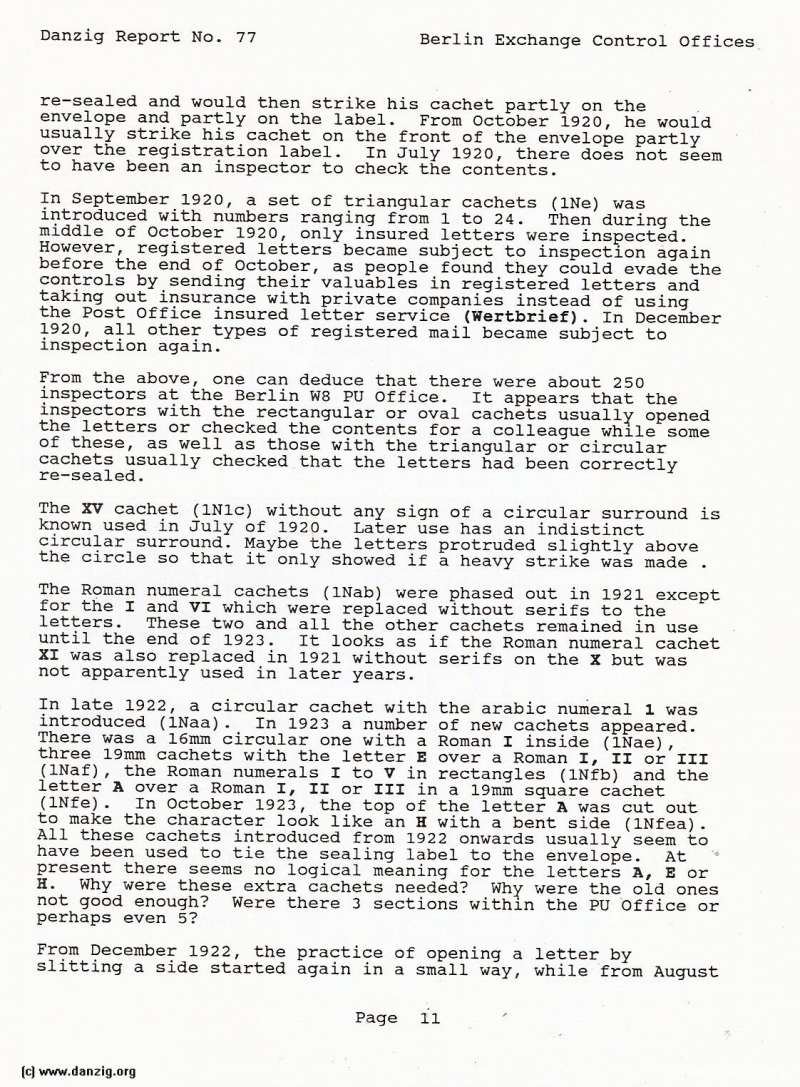
re—sealed and would then strike his cachet partly on the envelope and partly on the label. From October 1920, he would usually strike his cachet on the front of the envelope partly over the registration label. In July 1920, there does not seem to have been an inspector to check the contents.
In September 1920, a set of triangular cachets (iNe) was introduced with numbers ranging from 1 to 24. Then during the middle of October 1920, only insured letters were inspected. However, registered letters became subject to inspection again before the end of October, as people found they could evade the controls by sending their valuables in registered letters and taking out insurance with private companies instead of using the Post Office insured letter service (Wertbrief). In December 1920, all other types of registered mail became subject to inspection again.
From the above, one can deduce that there were about 250 inspectors at the Berlin W8 PU Office. It appears that the inspectors with the rectangular or oval cachets usually opened the letters or checked the contents for a colleague while some of these, as well as those with the triangular or circular cachets usually checked that the letters had been correctly re—sealed.
The XV cachet (1N1c) without any sign of a circular surround is known used in July of 1920. Later use has an indistinct circular surround. Maybe the letters protruded slightly above the circle so that it only showed if a heavy strike was made
The Roman numeral cachets (iNab) were phased out in 1921 except for the I and VI which were replaced without serif s to the letters. These two and all the other cachets remained in use until the end of 1923. It looks as if the Roman numeral cachet XI was also replaced in 1921 without serifs on the X but was not apparently used in later years.
In late 1922, a circular cachet with the arabic numeral 1 was introduced (lNaa). In 1923 a number of new cachets appeared. There was a 16mm circular one with a Roman I inside (lNae), three l9ram cachets with the letter E over a Roman I, II or III (iNaf), the Roman numerals I to V in rectangles (lNfb) and the letter A over a Roman I, II or III in a 19mm square cachet (iNfe). In October 1923, the top of the letter A was cut out to make the character look like an H with a bent side (iNfea). All these cachets introduced from 1922 onwards usually seem to have been used to tie the sealing label to the envelope. At present there seems no logical meaning for the letters A, E or H. Why were these extra cachets needed? Why were the old ones not good enough? Were there 3 sections within the PU Office or perhaps even 5?
From December 1922, the practice of opening a letter by slitting a side started again in a small way, while from August
Danzig Report Vol. 1 - Nr. 77 - October - November - December - 1992, Page 11.
Hits: 3651
Added: 03/07/2015
Copyright: 2025 Danzig.org

